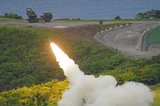Missile defence acquisition process needs more tweaking, says GAO
A ground-based interceptor missile test launch was conducted by the Missile Defense Agency, US Space Force and US Northern Command on 12 September 2021. (Photo: US Space Force/Airman Kadielle Shaw)
Recent acquisition policy changes by the DoD for US missile defence balance risk and flexibility but more must be done to refine the requirements process, the Government Accountability Office (GAO) concluded in a report published on 10 November.
The GAO stated that since the Missile Defense Agency (MDA) was established in 2002, the DoD has invested more than $174 billion in developing and fielding missile defence capabilities.
A flexible approach allowed the agency to develop and field capabilities quickly but it has also had ‘setbacks’, prompting the DoD to reform the MDA acquisition process in 2020.
Changes included more oversight from senior DoD officials and end-users were also given a greater role in setting requirements.
The GAO found that most of the reforms ‘align with best practices’ but the DoD is still not fully matching capabilities with user requirements.
‘Instead, DoD continues to rely on MDA to identify its own operational-level requirements, which could result in MDA later having to make costly, time-consuming design changes to meet warfighter needs,’ the GAO concluded.
The congressional watchdog issued three recommendations in its report. Operational-level ‘warfighter requirements’ should be woven into initial requirements documents, and the MDA should be required to ‘perform analyses of alternatives’ for all its major programmes ‘using warfighter-validated initial requirements documents’.
Thirdly, initial top-level requirements documents should be produced before technology development begins.
More from Defence Notes
-
![Taiwan approved for $11 billion weapon purchase from US]()
Taiwan approved for $11 billion weapon purchase from US
The US State Department’s approval of a multi-billion-dollar sale of weapons to Taiwan includes tactical mission networks equipment, uncrewed aerial systems, artillery rocket systems and self-propelled howitzers as well as anti-tank guided missiles.
-
![US National Security Strategy prioritises advanced military capabilities and national industry]()
US National Security Strategy prioritises advanced military capabilities and national industry
The 2025 NSS has emphasised investment in the US nuclear and air defence inventory and national industry, but it leaves multiple unanswered questions on how the White House will implement this approach.
-
![Canada set to look away from its neighbour and across the Atlantic for partners]()
Canada set to look away from its neighbour and across the Atlantic for partners
While non-EU UK struggles to join the Security Action for Europe initiative, which provides loans for defence programmes, Canada has become the first country outside Europe to get access – and did so for a nominal fee.
-
![NATO experiments with solutions to integrate networks, AI and uncrewed systems]()
NATO experiments with solutions to integrate networks, AI and uncrewed systems
During the latest edition of the NATO DiBaX, the alliance tested multiple capabilities to inform requirements for future efforts.
























